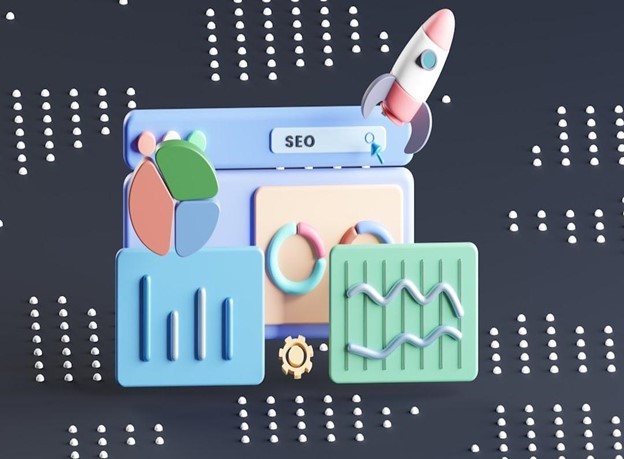Even in the midst of this competitive world of fashion e-commerce, that is not easy.
It is your SEO stage ticket to increased visibility, higher traffic, and more sales.
In this article, we’ll reveal the seven most effective SEO strategies for fashion e-commerce, putting you ahead of your contemporaries.

Fig 1. An illustration of what SEO can d to your online presence and business. [Source: Growtika]
Why SEO Matters to Fashion Ecommerce?
For any fashion e-commerce business to succeed, it must consider search engine optimization (SEO). When people enter a keyword related to fashion on search engines, you want your website to be ranked at the top of the of the page. More visibility means greater traffic, leading to higher sales.
Furthermore, SEO also boosts trust and credibility with your audience.
Often, when a site ranks highly on search engines like Google, users tend to believe that the brand is credible and trustworthy.
This aspect is important in fashion, where customer trust and brand loyalty are paramount.
Apart from that, investing in SEO improves the user experience on your site as well.
Some of the best practices in SEO, which include enhancing site speed, ensuring mobility friendliness, and generating good quality content, all contribute towards giving a better overall user experience, thereby increasing conversion rates.
1. Keyword Research: The Foundation of SEO
Any successful strategy or campaign requires a first step that involves keyword research work.
You need to find out what terms or phrases your potential customers are using while searching for products similar to yours before coming up with effective keywords.
Tools such as Ahrefs, Google Keyword Planner, and Semrush, among others, can help you find keywords relevant with high search volume but low competition .
Long-tail Keywords
Long-tail keywords may be longer phrases used by potential clients who know what they want.
Long-tail keywords have lesser search volumes but often convert better because these users are closer to making purchase decisions.
For example, instead of targeting “dresses,” you might focus on “summer floral dresses for women.”
Including long-tail keywords within your content helps you rank on a wider range of searches.
This can be particularly important for niche fashion items where competition may be low but purchasing intent is high.
By concentrating on these particular phrases, targeted traffic that results in more conversions can be captured.
2. On-Page SEO: Optimizing Your Product Pages
On-page or site specific SEO refers to the process of optimizing webpage content so that it will receive more search engine and user-related traffic. Key areas to consider include:
Title Tags and Meta Descriptions
Each product page must have its own unique title tag & meta description, which should include the keywords you are targeting.
These two elements help search engines understand what is inside your page as well as influence click-through rates from SERPs.
Product Descriptions
Write informative and detailed, unique product descriptions featuring relevant key words naturally.
Do not use duplicate content, as this may affect your SEO negatively.
The descriptions should be engaging and informative, providing all the necessary information needed by potential customers to make a decision to buy.
Image Optimization
Renew product images by using descriptive names and alt text that includes your desired keywords.
This will promote the search engines to understand what is being talked about in these images, leading to an improved position on image search result pages.
Also, make sure your pictures are of good quality but optimized for fast loading to improve people’s browsing.
Internal Linking
Also, internal linking, which is another important factor in on-page SEO, is referred to as a must-do.
It can assist the search engines in understanding your site architecture and dividing link equity through interlinking related products and categories within your website.
Moreover, it may result in increased visitor traffic for a longer period of time.
3) Technical SEO: Ensuring Your Site is Search Engine-Friendly
Technical SEO refers to optimizing the backend of your website so that it can be easily crawled and indexed by search engines. The key elements are as follows:
Site Speed
Fast-loading websites improve the user experience and ultimately give better rankings.
Use tools like the Google PageSpeed Insights to identify problems with slow performance on your site.
Common methods include reducing image sizes, leveraging browser caching, or minimizing CSS & JavaScript files.
Mobile-Friendliness
Ensure you have a mobile-friendly website because most online shoppers use mobile devices.
By doing this, you will improve the usability aspect of the site while at the same time improving its conversion rates.
A responsive design gaurantees that your site looks good & functions well on all sorts of devices, which can lead to higher engagement and conversions.
Secure Sockets Layer (SSL)
Having an SSL certificate ensures your website is secure, which is a ranking factor for Google and builds trust among users who visit it.
Especially when handling payment details, eCommerce businesses need secure sites since they deal with sensitive customer information.
XML Sitemaps and Robots.txt
If you want search engines to understand the structure of your site and find all the important pages, create an XML sitemap.
Similarly, a well-optimized robots.txt file can guide search engines on which pages are crawl and index, resulting in better overall SEO performance.
4. Content Marketing: Creating Valuable Content
Content marketing is about creating and sharing valuable content so as to attract and engage the target audience.
This may encompass blog posts, style guides, lookbooks, or videos in the case of fashion eCommerce.
Blogging

Fig 2. An image of a workstation by the window. [Source: Andrew Neel]
Develop a blog on your site where regular, relevant content is published for your audience’s benefit.
In order to increase organic traffic numbers for your website, consider using long-tail keywords that rank you highly on the search engine results page.
Blog posts could be about fashion trends, styling tips, behind-the-scenes brand stories, etc.
User-Generated Content
Ask clients to share pictures of themselves wearing products on social media hnadles where you can even use them for marketing purposes; such user-generated content has been known to improve SEO rankings and build social proof.
Similarly, reviews, testimonials, and customer stories can add credibility while enhancing brand trustworthiness.
Video Content
Video content is becoming the hype and thus important in SEO as it possesses great viral marketing potential.
Posting such videos as product showcases as well as fashion tips, among others, helps one get in touch with their audience, thereby improving their rankings too.
These videos can also be shared across platforms like YouTube and social media, thus increasing the reach of your message.
Lookbooks and Style Guides
Certainly, lookbooks and style guides can be major sources of inspiration as well as informative for your audience.
Through the inclusion of relevant keywords and internal links that make such content SEO-friendly, more organic traffic is attracted to these kinds of content.
5) Link Building: Earning High-Quality Backlinks
This refers to getting hyperlinks from other websites directing their visitors to yours.
Search engines often consider high-quality backlinks as a significant ranking factor.
Outreach
Fashion bloggers, influencers, and industry sites should be contacted for guest posts or features that would include a link back to your website.
Moreover, building relationships with industry influencers can result in more natural backlinks and increased brand exposure.
Content Partnerships
Valuable content, including mutual backlinks, can also be produced by collaborating with other brands or content creators.
Backlinks can also be obtained through co-hosting events, webinars, or even social media takeovers. Such partnerships will help you access new audiences and gain credibility.
Broken Link Building
The broken links on relevant industry websites should be identified, and your contents should be provided as replacements.
There are tools like Ahrefs and SEMrush that enable you to find such opportunities.
This is one way of gaining backlinks, besides helping them fix broken links, thus giving value to site owners.
Press Releases and PR Campaigns
This attracts quality backlinks from news sites and industry publications by sending out press releases regarding new products or big company news.
Participating in PR campaigns increases fashion authority while enhancing visibility for your brand.
6. Local SEO: Targeting Local Customers
If you have a physical store or serve customers within specific geographic locations, you may want to use local SEO techniques.
Google My Business
Your Google My Business profile must be created and optimized.
Additionally, make sure your business information is correct and current, and encourage satisfied customers to leave positive feedback.
Answering reviews demonstrates that consumers’ commentaries are valued, which consequently improves your local rankings.
Local Keywords
Your content as well as your meta tags should feature local keywords.
Some examples for New York could be “New York fashion boutique” or “NYC women’s clothing store.”
These keywords help bring in more localized traffic and increase visibility for searches on local terms.
Local Citations
List your enterprise on Yelp, Yellow Pages, and the and the local chamber of commerce website, among many other citation sites and directories online around you.
Similarly, a consistent Name, Address, Phone Number (NAP) structure in these listings enhances your performance in the local SEO sector, making it easy for customers to find you.
Local Content
Develop content that is unique and worthy for your audience in your area.
This can be blog posts about events happening locally or even collaborating with influencers from this place. Such localized content will enable you to interact more with people around you, thus enhancing the quality of search results.
7. Monitoring and Analytics: Measuring Your Success
Keep an eye out for what is working in SEO while also noting areas where improvements can be made through regular monitoring of performance in SEO.
Google analytics aka the Google search console may yield some useful insights with respect to user behaviors, rankings, and traffic statistics that might assist you when analyzing either of them.
Key indicators
Monitor key indicators such as organic traffic, bounce rate, average session duration, and conversion rate.
They help you determine the effectiveness of your SEO strategies.
Understanding these metrics will also guide your future SEO efforts by showing you what works best.
Routine checks
Carry out routine audits on SEO to establish and fix any abnormalities that could affect performance.
It can keep you ahead of algorithm changes while holding onto rankings.
Things like broken links, duplicate content, and technical errors are identified during audits.
Competitor analysis
You should regularly analyze the SEO strategies of your competitors to uncover opportunities for growth and threats to your own success.
Tools like Ahrefs and SEMrush can assist in identifying the major keywords that competitors are ranking for, as well as where they’re getting backlinks from.
This information will assist you in better tailoring your own SEO approach.
Reporting & Tweaking
Develop regular search engine optimization reports that allow you to track progress & share outcomes with stakeholders.
Use this data to make informed adjustments to your strategy, ensuring that you continue improving SEO performance over time.
Conclusion
For fashion eCommerce businesses, implementing these seven SEO strategies will increase their online visibility, drive more traffic towards them, and ultimately push sales up.
With a focus on keyword research, on-page/technical SEO aspects, content marketing link building, local SEO monitoring, and many other things, an e-commerce business is able to create a strong foundation upon which it can build its long term success.
Remember to always stay abreast of new trends and best practices in relation to search engine optimization if you wish your brand to be at the top of searches related to fashion products.
Regular updates of SEO tactics in line with the ever-altering algorithms of search engines are necessary for remaining competitive in the case of fashion e-commerce sites.
By continuously analyzing their strategies for possible necessary improvements, brands maintain relevancy within a saturated market, thereby preserving their visibility.
We, Wildnet Technologies, have catered to 2100+ and successfully helped them reach their marketing and business goals via our digital marketing services and ecommerce seo services.
FAQs
FAQ 1. What is SEO in fashion?
Ans: Well, starting from the keywords that users use to search for a fashion accessory to the appropriate SEO management of a website or an ecommerce store that caters to that fashion accessory, SEO has an infinite role in fashion.
FAQ 2. Does SEO work for eCommerce?
Ans: Just by using our Ecommerce SEO service, we have helped our clients increase their conversion rate by 40% to generate 100k+ leads!
FAQ. 3 Which eCommerce platform has the best SEO?
Ans: Shopify is the best Ecommerce platform for SEO with its in-built plugin.
FAQ 4. What is the best tools for eCommerce SEO?
Ans: The best tools for Ecommerce SEO are,
– Screaming Frog,
– Ahrefs,
– SEO Spider,
– MOz Pro,
– Google Seach Console,
– Google Analytics, and
– Ubersuggest.
FAQ 5. What is the difference between SEO and eCommerce SEO?
Ans: SEO focusses on generating more traffic and thus increasing the DA or domain authority of a website which thus means a higher ranking on SERPs and inherently more leads!
While Ecommerce SEO solely focuses on more leads and boosted ROI.
Read More Blogs
- Social Media Marketing Techniques for Fashion Brands in 2024
- Digital Marketing For Fashion and Clothing Brands: How To Build A Profitable Business
- Strategy for Marketing by H&M: Fashion Retail Domination Recipe
- Top 10 Marketing Strategies for Your Fashion Brand
- E-Commerce Marketing Secrets: How Delhi NCR Best Digital Marketing Company Can Transform Your Business
- E-Commerce SEO and its Best Practices in 2024
- E-Commerce Marketing Magic: Strategies for Sustainable Business Growth
- All about ecommerce and its purpose






